The United States Navy
..
The US Navy in World War II
.
The United States maintained a “two-ocean”
Navy throughout World War II, and became the most powerful fleet in the
world with over 2,500 ships
(including 24 battleships, 112 aircraft carriers
and escort carriers, 92 cruisers, 907 destroyers and destroyer-escorts,
and 262 submarines). |
..... |

US Navy fleet in the Hudson
River during WWII
|
.
 Admiral Ernest J. King,
USN
Admiral Ernest J. King,
USN
|
..... |
Equipped with these overwhelming forces and
modern technological advances in radar and weaponry, the American Navy
established absolute dominance of the sea.
It was also assisted greatly by intelligence
activities that broke both the Japanese and German wartime codes (enabling
constant detection of enemy plans and locations everywhere).
Admiral Ernest J. King was commander of the
United States Fleet, and later became Chief of Naval Operations. |
.
The Battle of the Atlantic
.
| American naval participation in Battle of
the Atlantic against the German submarine menace began in 1940, although
this conflict was undeclared for almost two years.
The first American warship (destroyer Reuben
James) was sunk in October 1941, two months before the United States
formally entered the war. |
....... |
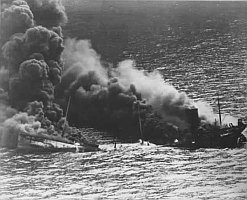
The U.S.S. Reuben James
sunk with the loss of 115 of 160 crewmen, including all officers
|
.
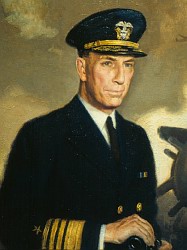 Admiral Royal E. Ingersoll
Admiral Royal E. Ingersoll
|
......... |
Admiral Royal E. Ingersoll commanded the Atlantic
Fleet. The war in the Atlantic was waged despite difficult weather, frightful
ship losses, and challenging enemy underwater tactics.
American naval victory enabled desperately
needed military supplies to reach the Soviet Union, and troop-filled convoys
to successfully cross the ocean and invade Nazi-held Western Europe. |
.
The Battle of the Pacific
.
| American naval participation in the Battle
for the Pacific began on December 7, 1941, when the Japanese attacked the
Navy base of Pearl Harbor, Hawaii, in a crippling surprise attack.
Right Picture:
View looking up "Battleship Row"
after the Pearl Harbor Attack, The USS Arizona is in the center,
burning furiously. |
....... |
 |
.

Fleet Admiral Chester W. Nimitz,
USN
|
... |
Admiral Chester W. Nimitz assumed command
of the Pacific Fleet.
The Navy fought several delaying actions while
recovering from its Pearl Harbor losses.
Thousands of new ships were built for the war
effort. |
... |
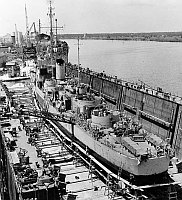 Building of the USS Slater
by the Tampa Shipbuilding Company
Building of the USS Slater
by the Tampa Shipbuilding Company
|
.
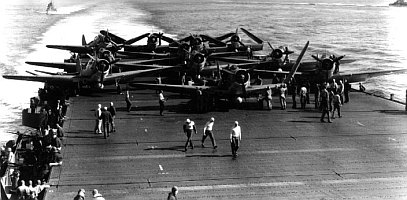 Battle of Midway, June 1942:
Torpedo Squadron Six (VT-6) TBD-1 aircraft
Battle of Midway, June 1942:
Torpedo Squadron Six (VT-6) TBD-1 aircraft
are prepared for launching on USS
Enterprise.
|
..... |
During 1942, the Japanese advance was stopped
at the Battle of Coral Sea in May and the Battle of Midway in June.
Both engagements were fought by carrier-based
warplanes. |
.
| The Navy then led invasion armadas to retake
Japanese-held territory. In 1943, the enemy fleet was countered in a series
of sea battles around the Solomon Islands.
Increasing carrier raids against far-flung
targets caused further Japanese losses, and their remaining fleet was largely
destroyed in the great 1944 battle of Leyte Gulf around the Philippine
Islands.
In 1945, the Japanese finally surrendered aboard
the battleship Missouri in Tokyo Bay. |
..... |
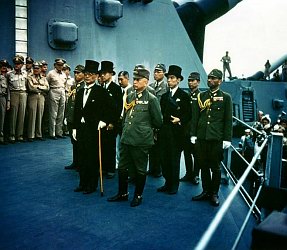 Representatives of Japan stand
aboard the USS Missouri prior to signing of the Instrument of Surrender
Representatives of Japan stand
aboard the USS Missouri prior to signing of the Instrument of Surrender
|
.
Navy Women in WWII
.
The Navy also brought women into the service
in large numbers during World War II. One the one side, there was the already
existing Navy Nurse Corps which was enlarged.
On the other side, there was a new component created by an act of congress
in July 1942: the Women's Reserve of the United States Naval Reserve, known
as the WAVES (which was based on the abbreviation for "Women Accepted for
Volunteer Emergency Service.")
.
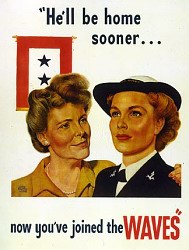 |
...... |
This act was designed to appoint and enlist
women as a necessary wartime emergency measure, in order to replace men
who could thereby be released for active sea duty in the operational fleet
forces.
The WAVES were intended to fill vacated and
newly created positions within the United States shore establishment.
Legislative amendments also allowed WAVES to
serve beyond the mainland United States in designated stations in the US
Territories and overseas. |
.
.
.
[ I. Development ]..[
II. Facts about the WAVES ]..[
III. Uniforms ]..[
IV. Sources ]
|
